
Stalin’s Most Apt Pupil
On 16 February 1971 his cremated remains were returned to Budapest and buried in a grave marked only with his initials. Not included on his epitaph, although he frequently proudly proclaimed it in public, was “Stalin’s Best Hungarian Disciple.” In the end, it was his dogged clinging to Stalinism which sealed his fate.
The future uber-Stalinist was born in 1892 under a different name, and in a different country. As a Jew in Vojvodina, then part of the Hungarian Empire and now a part of Serbia, He was originally Matyas Rosenfeld. His father Joszef repudiated religion and became a Marxist Atheist in 1903, changing the family’s name to the more Hungarian Rakosi. Matyas Rakosi’s communist leanings did not appear out of thin air.
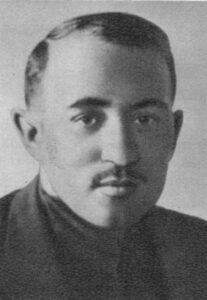
As a student he was the secretary and an active member of The Galileo Circle, an anarcho-syndicalist movement dedicated to using labor unions to gain control of the means of production. He also joined the Social Democrat Party of Hungary (MSZDP).
And then Rakosi struck the jackpot, even if it didn’t seem so at the time. He was captured on the Eastern Front while fighting in the Austrian Army in 1915. Sent to a Russian prison camp, Rakosi managed to escape during the upheaval of the Revolution and spent the seminal days of the Communist takeover in Petrograd, soaking in the violence and Marxist theory.
That direct Soviet experience was parlayed by Rakosi into a position in the short-lived Hungarian Soviet Republic in 1919, and guaranteed asylum back in the USSR when the Republic fell in August of the same year as well as a position at Communist International.
Rakosi’s preternatural ability to choose the most expeditious path for his future faltered once – when he returned to Hungary in 1924. He was promptly arrested and sat out the next fifteen years in prison until he was exchanged with the Soviet Union for a set of revolution flags from the 1848 Revolution. Upon his arrival in the USSR, Rakosi was made the leader of COMINTERN.
His expeditious trade to the USSR saved his life yet again; the former Matyas Rosenfeld was not in Hungary when the Arrow Cross and the Nazis deported and murdered 400,000 ethnically Jewish Hungarians.
He returned on 30 January 1945, following the Red Army, with the blessing of the Soviet Politburo, to organize the Hungarian Communist Party. And it is at this point that, appointed General Secretary by the Communist Party of the Soviet Union (CPSU), that Rakosi’s climb to full power was assured.
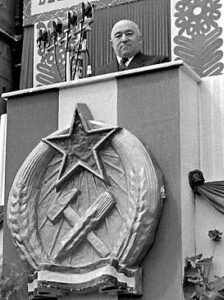
Although Rakosi bounced in and out of a position as Prime Minister, as General Secretary of the Hungarian Communist Party he had far more power. Using a technique referred to as “salami tactics” (destroying other parties by cutting them off like pieces of salami) and branding those who were uncooperative as fascist or fascist sympathizers, by 1947 power was consolidated solely with the Communists and, through them, Rakosi. There was no longer even a pretense of being a multi-party democracy, opposition parties were told to either cooperate or go into exile. Fully supported by the Soviet Union, Hungary was now Rakosi’s personal fiefdom.
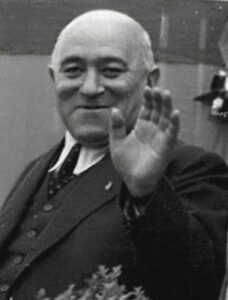
He inaugurated his reign by beginning purges that would result in more than 2000 executions, 100,000 imprisonments, and more than 200,000 expulsions from the Hungarian Communist Party. He personally took charge of the AVH, Hungary’s secret police, directing the official directors. A former head of COMINTERN, he took the Tito-Stalin split personally and began the Soviet sphere’s hunt for those committing the crime of being a “Titoist” by executing a political rival, Laszlo Rajk.
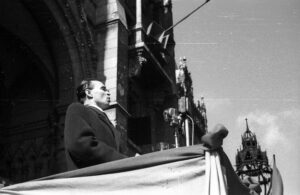
“Anyone who leaves this community has, by this step in itself, ceased to be a State of the People’s Democracy and builder of Socialism, and inevitably crashes back into the camp of the capitalists and imperialists. The six months’ history of the treachery of the Yugoslav leaders provides spectacular proof of this,” Rakosi crowed in his essay, Some Problems of the People’s Democracy.
Searching out Titoists in the shadows gave Rakosi a purpose, but also allowed him to ignore the deepening economic issues plaguing Hungary. There were frequent shortages, the highest rate of inflation in world history to that point, an onerous burden of war reparations owed, a lack of consumer goods, and wages were stagnant at a level below the rate of inflation. People were starting to get angry. The were angry enough that even the USSR, normally oblivious to Hungarian issues, began to notice. Rakosi, the uncompromising Stalinist, was also falling out of favor with the post-Stalin Soviet Union. In June 1953 Rakosi was summoned to Moscow to receive strict directions to fix the economic system, and on 13 June 1953 Rakosi was replaced in the premiership by Imre Nagy, although he retained the chairmanship of the Hungarian Communist Party – the real source of political power.
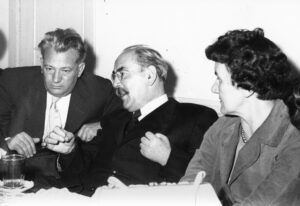
The Chairmanship was not enough for Rakosi – he wanted everything. Nagy had to go. A campaign of political sabotage ensued, and two years later, on 9 March 1955, Nagy was labeled a “rightist”, blamed for all Hungary’s economic problems, and removed from his position and membership in the Hungarian Communist Party. The Soviet Politburo didn’t fully agree with these actions, but as Krushchev told Tito in one of their secret meetings, “I have to keep Rakosi… because in Hungary the whole structure will collapse if he goes.”
Nor were events in Hungary happening in a vacuum. Issues in Poland were the most pronounced, but the Soviets felt they were loosing ground in multiple satellites – and even at home within Russia itself. Rakosi was a problem, but he was *their* problem; and one who would never abandon communism or turn against his Soviet handlers. If anything, he was too enthusiastic- one of the biggest complaints about his leadership was that he was too slow in implementing destalinisation policies.
“The detainees are being released slowly. This is Rakosi’s fault, because he hasn’t taken the matter in hand. Rakosi alludes to the fact that his nerves are bad. Nerves don’t count!” said Khrushchev in regards to Rakosi’s halting efforts to implement the prime destalinisation policy of releasing political prisoners.
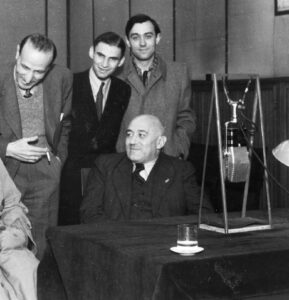
The Hungarian party members saw the issues developing between Rakosi and the rest of the nation. Anti-semitism was on the rise, but it was a unique anti-semitism related more to hatred of Rakosi himself than of the vastly reduced number of Hungarian Jews. The code words identifying this burgeoning anti-semitism was that someone “of Hungarian Nationality” was needed in leadership. Party members, sensing that the Politburo still saw Rakosi as Hungary’s only hope but understanding that events would soon carry him off in one way or another, began to couch their reports to Moscow with terms of ambiguity. Imre Nagy, still smarting from his defeat at Rakosi’s hands, was the exception and wrote, “Since Lenin’s death, further development of Marxist-Leninist method has been replaced by drastic regulations, denunciations, and methods of power,” Nagy wrote in one pamphlet. In another, he directly attacked Rakosi’s methods of rule, “Power is not imbued with the spirit of socialism and democrats, but with the spirit of minority dictatorship; of Bonapartism.”
But still, although they sent Mikhail Suslov to investigate the situation in Budapest in June 1956, the Politburo still hesitated to remove Rakosi. Suslov mentioned that anything Rakosi had done had been at the behest and with the blessing of Stalin, but perhaps the biggest reason to keep him in power was to deny what would certainly be a propaganda gift to the Americans.
“Rakosi is no more to blame than we are in Moscow,” Suslov said.
Rakosi himself understood that he was a cause of the current of unrest sweeping Hungary at the time, but was at a loss in how to confront and manage it. “If we arrest some, others will make trouble; if we arrest them, still others will revolt, and there will be no end to it.” It proved to be a prophetic statement.
But, in the end, Rakosi’s unrepentant anti-Titoism was proving too much of a hindrance to the healing relationship between the Soviets and Yugoslavia. He was ignoring the developing relationship, continuing with his anti-Yugoslav rhetoric, and it was an issue. Reluctantly, the Politburo agreed that Rakosi had to go.
And, on 17 July 1956, Matyas Rakosi was removed from power and forced to return to the Soviet Union, ostensibly to receive necessary medical treatment. He would never return alive to Budapest.
There were a few humiliations still to come, however. On 5 November 1956, as the Red Army was violently retaking Budapest from the revolutionaries, Rakosi was permanently removed from power in Hungary. In 1962 he was permanently expelled form the Hungarian Communist Party. And in 1970, in response to his request, he was granted permission to return to Hungary only if he undertook a guarantee that he would not engage in political activities. He refused.
And then, quickly, he died.
For More on the Hungarian Revolution, see:
Russians Go Home!
- November 2, 2020
- History , Interesting
